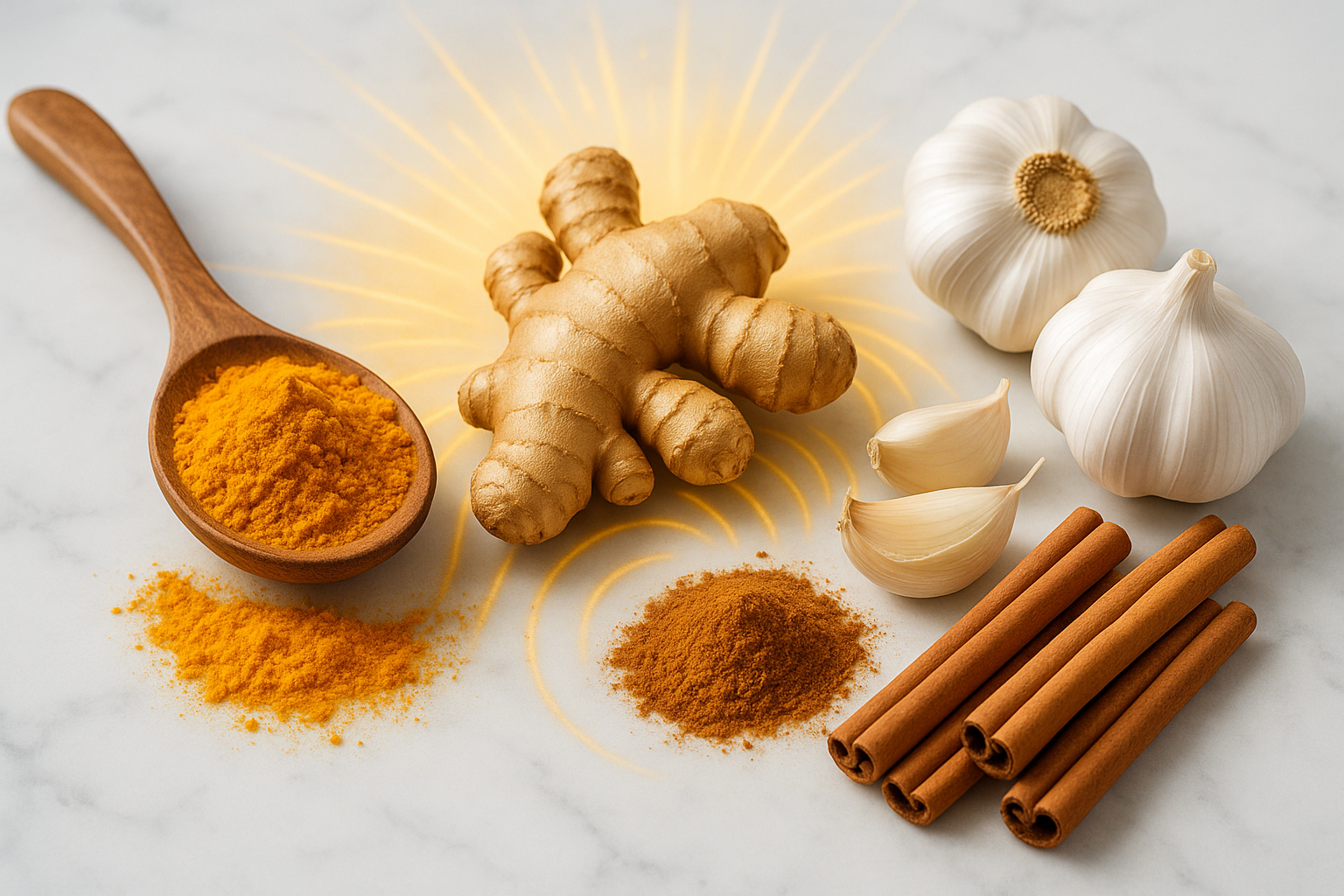- anti-inflammatory cooking, anti-inflammatory diet, anti-inflammatory wellness drink, bioperine absorption, black pepper health benefits, chef powerlifter health tips, chef wellness recipes, chef-inspired health drinks, culinary wellness drink, healthy broth drink, healthy broth with spices, metabolic wellness tote, natural immune booster, Stephen Matthews wellness, turmeric and pepper wellness, turmeric bioperine recipe, turmeric black pepper benefits, turmeric black pepper broth, turmeric curcumin drink, turmeric drink for athletes, yoga recovery drink
- Stephen Matthews
Golden Ritual: How My Twice-Daily Spice Cup

Golden Ritual: How My Twice-Daily Spice Cup — with Turmeric, Ginger, Garlic & Cinnamon — Transformed Stephen Matthews’ Body, Mood & Performance
By Stephen Matthews
I started this small ritual a year ago—no bold declarations, just a daily act, morning and evening: a warm, golden cup that rose like aromatics from old kitchens and offered a quiet invitation to pause and reset. I’m Stephen Matthews: chef, powerlifter, canoe and rower enthusiast, beginner yogi. My days are full of flavor, strength, water strokes, and stillness-seeking breath. And for twelve months now, that humble spice-infused drink has steadily rewired how I feel physically—and emotionally.
Here’s what I’ve gained: knees that echo the confidence of solid foundations, not the irritation of wear; digestion that hums instead of protesting; cravings that now politely defer; soreness and swelling from lifts and paddling that fade faster. My mood, too—unexpectedly steadier, quieter, more grounded.
I wanted to share this—not as sales copy, not as preachy—but as a story that’s part chef-biography, part training log, part personal experiment, dark-roasted with emotion, brightened with science. My hope is that on Medium, LinkedIn—or a corner of tekaoriginals.com—someone else reading this might think, “Yeah. I’ll try that.”
Metabolic Wellness Spices Tote – Global Flavor Tote Bag
Four Spices, Four Legacies: Origins, Powers & Why They Belong in My Cup
1. Turmeric – The Golden Core
From the Curcuma longa root, native to South Asia and cherished in Ayurveda and traditional Chinese medicine for centuries. Its bright orange hue comes from curcuminoids—especially curcumin, a polyphenol that’s been studied extensively for its anti-inflammatory and antioxidant powers. Studies show promise for curcumin’s benefits in easing joint discomfort, supporting metabolic wellness, and quelling inflammatory pathways.
The hitch? Curcumin is notoriously poorly absorbed when consumed straight from the spice jar. That’s why serious formulations come standardized—say, 95% curcuminoids—or packaged with absorption enhancers like piperine (black-pepper extract) or in phytosome formats.
In my kitchen-lab, I lean on the food-first philosophy: a generous teaspoon of culinary turmeric powder into coconut milk, black pepper to unlock it, a little fat to carry it. The spice-cup is comfort, ritual—and efficacy.
2. Ginger – The Warm Mover
Zingiber officinale, electric with ancient roots in cooking, from broths to baked goods. Its active compounds—gingerols and shogaols—carry analgesic, anti-inflammatory, and digestive benefits. Clinical studies support ginger’s ability to ease osteoarthritis, soothe post-meal bloating, and aid recovery from physical exertion.
Fresh ginger brings bright and assertive heat; dried or powdered offers a slow underpinning of warmth. In my blend, I alternate between freshly grated root (it smells like waking up) and powder for convenience—and each shift subtly alters the sensory and chemical signature.
3. Garlic – The Bold Balancer
Allium sativum: not subtle, but powerful. Crush it, and allicin is born—a volatile sulfur compound with antimicrobial, cardiovascular, and immune-modulating potential. Its instability means that aged-garlic extracts (like Kyolic) have emerged as gentler, more lipophilic pathways to cardiovascular wellness and immune support.
I’ll confess: on tough workout days, I’ll crack a fresh clove into the warm cup (the aroma punches). But on yogi-soft days—or if I’m pacing digestion—I’ll use a teaspoon of aged-garlic extract. The full-clove option keeps my senses honest; the extract keeps my gut peaceful.
4. Cinnamon – The Sweet Stabilizer
The bark of Cinnamomum trees, especially Ceylon ("true") and Cassia, has spiced kitchens for millennia. Cinnamaldehyde and related molecules are studied for their glucose-modulating effects, anti-inflammatory tone, and mild antimicrobial properties. Cinnamon often helps temper post-meal glucose spikes—blunting sugar cravings and stabilizing energy.
I always opt for Ceylon cinnamon. Cassia can carry coumarin in higher quantities—a liver stressor with frequent high-dose use—so for daily ritual, true Ceylon is my safer path.
Black Pepper & Bioperine – The Secret Multiplier
Black pepper isn’t just the finishing touch to your dinner plate—it’s a nutritional powerhouse when paired with the right ingredients. The magic comes from Piperine, and in its concentrated form—BioPerine®—it turns your wellness drink into a nutrient absorption machine. Think of it as the “open sesame” for your body’s nutrient gates. BioPerine has been shown to increase the bioavailability of key vitamins, minerals, and plant compounds by up to 2000%. In plain chef-speak: it helps your body actually use all the good stuff you’re putting into it. Without it, some nutrients just pass through like an uninvited dinner guest. With it, they stay, work, and fuel you—whether you’re in the kitchen, on the water, under the barbell, or holding that first awkward yoga pose.
… That morning ritual evolved into something more—a visual reminder of wellness. It even led to this tote, the Metabolic Wellness Spices of the World Tote.
Why These Four, Together? The Synergy in My Mug
Each spice carries its own pharmacology, but together they chart a multidimensional relief map for the body:
-
Turmeric’s curcuminoids modulate inflammatory signaling at the molecular level.
-
Gingerols/shogaols attenuate prostaglandins and leukotrienes, helping with pain and swelling.
-
Garlic sulfur compounds support vascular tone, immune ease, and slow-burn inflammation.
-
Cinnamon smooths glucose and appetite spikes, indirectly lowering metabolic stress.
That’s four distinct mechanisms, converging. Preliminary studies and lab models even show additive—or sometimes synergistic—inhibitory effects on inflammatory pathways when these spices are combined.
For my knees, that’s structural and inflammatory resilience. For paddling and lifting, that’s recovery and swelling dialed down. For training consistently—and riding emotional waves—that’s a steadiness I didn’t anticipate.
Recipe:
1 heaped 1/4 Tspn Ginger
1 heaped 1/4 Tspn Garlic
1 heaped 1/4 Tspn Cinnamon
1 heaped 1/4 Tspn Turmeric
1 heaped 1/4 Tspn Black Pepper
I use ground spices that you can purchase from the Grocery Store.
Drink 2x a day: Morning and before Bed.
My Ritual: Step by Step
-
Blend (or stir): a teaspoon turmeric powder, fresh-grated or powdered ginger (about a tablespoon or one 'pinchful'), a small clove of garlic (or a teaspoon of aged-garlic extract), half a teaspoon of Ceylon cinnamon.
-
Add: a tiny pinch of black pepper, then coconut milk (enough for a small mug)—the fat activates curcumin’s solubility.
-
Warm gently over low heat—just shy of simmering. Let the aromas swirl, then pour into my favorite cup.
-
Ritual pause moment: sip slowly. Morning message to self: We are here, we begin. Evening message: We unload, we rest.
I track how I feel: pain, cravings, digestion, knee strength, mood. Every few months I’ll tinker—fresh turmeric if I’ve run low, switch to aged-garlic extract if my stomach protests, or go full extract (curcumin standardized formula) for a week if training volume spikes. But always—always—whole-food first.
Form vs. Whole Spice: What’s in the Cup
-
Whole spice (food): contains fiber, minor phytochemicals, culinary texture, and psychological comfort. Modest doses, gentle; excellent for long-term habit.
-
Standardized extracts: predict dose, punch potency, more consistent for supporting conditions—but require sourcing diligence (heavy-metal testing, COAs), safety awareness, and physician consultation (for liver, blood sugar, blood-thinner users).
Because I’m health-savvy, I keep a small stock of quality extracts (95% curcuminoids with piperine; gingerol-standardized extract) for when training piles on and I want extra support. Otherwise—food-first.
The Tracking Data: What Actually Changed Over 12 Months
| Domain | Beginner State (12 Months Ago) | Today’s Summary Result |
|---|---|---|
| Knees | Twinged after squats/lunges | Strong, uncomplaining—safe in yoga poses |
| Digestion | Bloating, irregularity | Smooth, predictable, easy |
| Cravings | Sugary, mid-afternoon hits | Fewer, manageable, more mindful |
| Recovery & Soreness | 24–48 h after heavy training | Sometimes next-day refreshed |
| Mood/Emotional | Restless, reactive | Steadier, centered, less habitual stress |
These shifts weren’t overnight. But by 4 weeks, I noticed the digestive calm. By 2 weeks, fewer cravings. By 4 weeks, my recovery shortened; my powerlifting weights feeling more forgiving. By a year? I just feel grounded—morning waves don’t throw me off; I move through the day stronger, calmer.
Safety & Practical Notes (I’m a Chef + Athlete—But I’m Also Cautious)
-
Culinary spice doses are generally safe—but if you're using high-dose extracts:
-
Turmeric/curcumin: monitor liver enzymes occasionally; watch for GI upset; interact with anticoagulants or antidiabetics.
-
Ginger: in large amounts may thin blood or intensify ulcers—keep modest.
-
Garlic: raw can be potent; aged extract is milder. Watch GI tolerance.
-
Cinnamon (Cassia): high coumarin –- prefer Ceylon for daily use.
-
-
If pregnant, nursing, taking medication, or with medical conditions, check with your clinician.
-
Quality matters: I only use extracts from reputable brands with third-party analysis for purity and active ingredient content.
Why This Story for Medium.com, LinkedIn & TekaOriginals.com
-
On Medium: This is a personal, sensory-rich essay rooted in lived experience and thoughtful science. It invites readers into your life as chef, lifter, paddler, yogi—and the way simple ingredients changed your interior weather.
-
On LinkedIn: It’s a crafted, health-conscious leadership story: discipline, experimentation, integration of culinary insight and performance. It speaks to professionals building resilience, high performance, and self-care.
-
At TekaOriginals.com: The home for your creative and functional design ethos—this narrative connects your culinary artistry and body-wisdom with a tangible, approachable wellness ritual that embodies what “original” means: bold, tested, sensory, personal, enduring.
In Summary — in My Own Voice
I’m Stephen Matthews: trained in kitchens, under barbells, on rivers, on yoga mats—trying to live well. A year ago I began with a cup: four humble spices, two times a day. It wasn’t revolutionary. It was persistent. It became the smell-ritual that taught me bigger lessons: that real strength includes softness, healing is small steps, and flavor can lead to feeling.
Strong knees, quiet digestion, tamed cravings, faster recovery, steadier mood—without gimmicks, only spices and stories and intention. That’s what this is. Blessings to you wherever you try your own version. If this moved you—or if it sparks your curiosity—I’d love to hear how your body replies.
